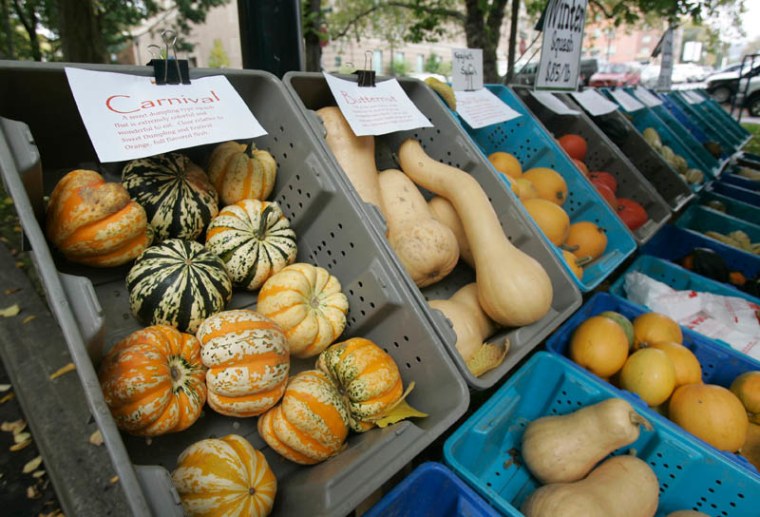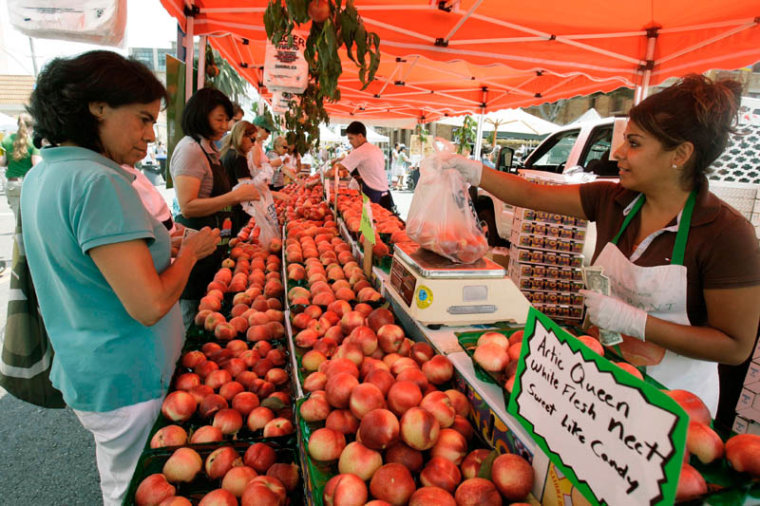Unplug the sous-vide bath and throw that imported Spanish saffron to the dogs. In case you haven’t heard, there is a new cooking trend, and it has people leaving the air-conditioned supermarket aisles behind. “When people begin to experiment a little bit and start shopping outside the grocery store, they get hooked,” says Erin Barnett of Local Harvest.com, a local and organic food Web site. And where are these adventurous consumers going? To the farmers’ markets, of course.
According to the Agricultural Marketing Service, farmers’ markets in the United States have increased 18 percent since 2004. Leading this market movement is a group of citizens known as locavores. The word—Oxford Dictionary's "Word of the Year in 2007" — refers to anyone who is committed to eating as locally and seasonally as possible. Along with the movement came an eating trend: the 100-Mile Diet in which those who subscribe to it try to eat only locally produced food that is grown less than 100 miles from where they live and shop. This is where greenmarkets come in particularly handy.
But before we call local produce the latest bandwagon pulling through town, consider this: local produce and farmers’ markets predate even the earliest bandwagons. When talking about local foods, Frederick Kaufman, author of "A Short History of the American Stomach" is quick to note that “local food in New York has always been a thriving enterprise.”
Whether you’re steering today’s local food bandwagon or simply attempting to eat and cook like your ancestors, there is one thing all farmers’ markets connoisseurs know—these gastronomic gatherings are much more than just a place to buy produce. “You have the food all coming from one place,” Molly Watson, Guide to Local Foods for About.com says, “and the people shopping are all coming from that place. It gives you an instantaneous view of the culture.”
For Ms. Watson, no place is a better snapshot of the local scene than the St. Paul Farmers’ Market in St. Paul, Minn. This quiet Midwestern city is also to the United State’s second largest Hmong population, an Asian ethnic group hailing from the mountainous southern region of China. So, in addition to the traditional mid-western fare (artisan cheeses and the sweetest of sweet corn), you’ll find time-honored Asian favorites, including spicy peppers in every color of the rainbow.
Over in the Southwest, chilies echo the deep history that lies beneath the burnt soil of New Mexico. At least that’s what George Gundrey, Executive Director of the Santa Fe Farmers’ Market says. Gundrey notes, “Some of these farmers have been on the land that has been in their families for 150-300 years.” Chew on that as you take in the haunting aroma of roasting chilies during chili season in Santa Fe, which typically hits its peak around September.
While the produce selection at a farmers’ market is often an ode to the area’s fields and farmlands, what goes on between the vegetable stands speaks volumes about the local vibe and culture. Markets often feature musical performances, chef demonstrations, and free samples that are only limited by how many morsels your toothpick can hold. It is a collection of events, that Chef Michael Tuohy of Woodfire Grill in Atlanta aptly calls “a happening.”
According to Leather Storrs, chef at Rocket in Portland, Ore., no place is more of “a happening” than the Portland Farmers’ Market. “The market is a great way to get the tenor of the season,” the chef says. If late-summer produce like parsnips and apples don’t make the sound of crunching autumnal leaves ring in your ears, no worries. The Portland Farmers’ Market also hosts events like the Community Corn Roast in late August and the Great Pumpkin Event in October to put even the most reluctant shopper into the spirit of the season.

In New Orleans, where warm temperatures allow the Crescent City Farmers’ Market to operate year round, a different type of “happening” is taking place. After Hurricane Katrina ravaged much of New Orleans, the market and its parent company, MarketUmbrella.org, attempted to reinvigorate the community with local produce. Darlene Wolnik, Deputy Director for Mentoring at MarketUmbrella.org, says that a year after the storm, damaged neighborhoods called her about setting up farmers’ markets. “We want to control our economic future. We want to put locals to work,” the neighborhoods told her. With several markets across New Orleans, local produce is an unlikely force shaping the new face of New Orleans. The untold story in New Orleans, Ms. Wolnik says, is that “neighborhoods are determining the city’s future.”
While many trends are destined to fade just as quickly as they came about, the local food movement seems as though it will have staying power. Frederick Kauffman reasons pretty soon, people might “own a piece of the cow.” Until then, there’s more than enough to buy at your local farmers’ market.
